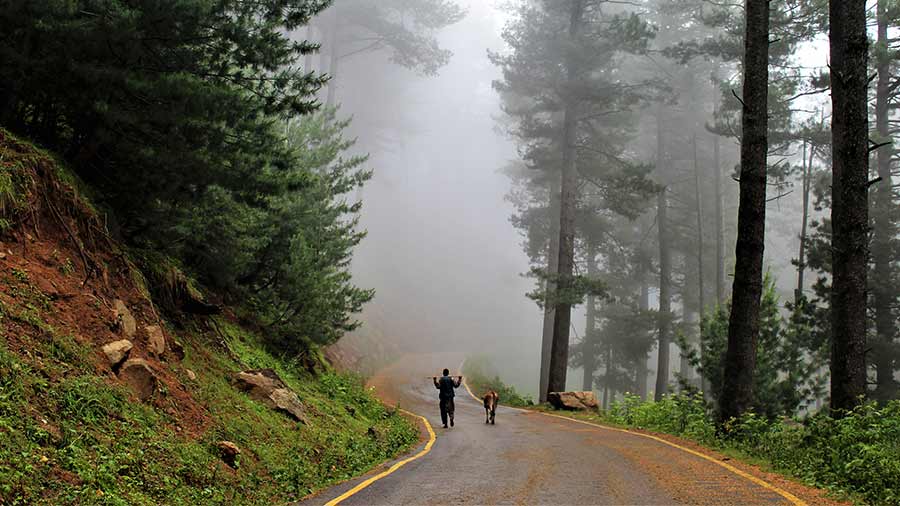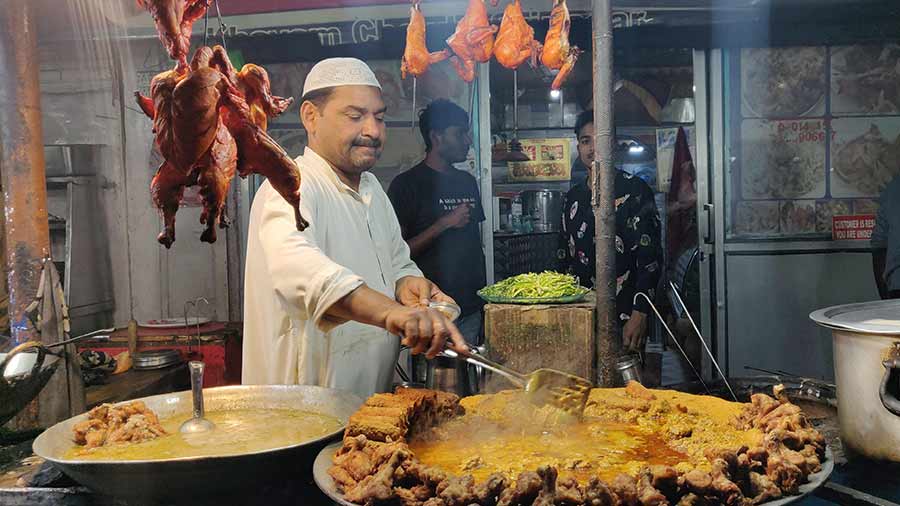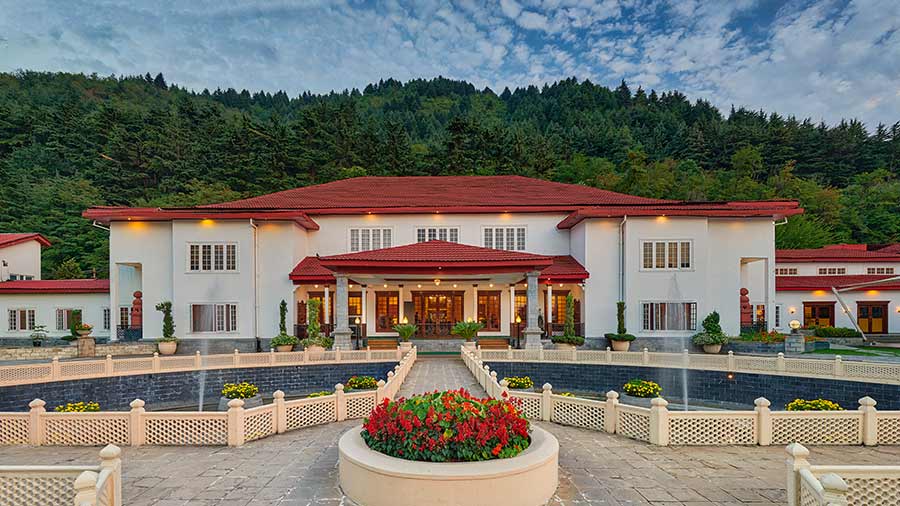I caught brief glimpses of the little party in between the military trucks that roared their way to the Razdan Pass top. The five horses — one carrying a couple of children and the others with loads on their backs — trotted up the paved path as a woman and three girls measured their pace alongside. All of them — barring the youngest on horseback, a mere toddler — had their hijabs in place.
They were likely Gujjars, one of the two nomadic tribes that roam the pristine mountains of Kashmir — the other being the Bakarwals, identifiable by their flocks of sheep and goats. These nomads and the men with automatic rifles in the olive-green trucks seemed to belong to parallel universes, merged only by chance.
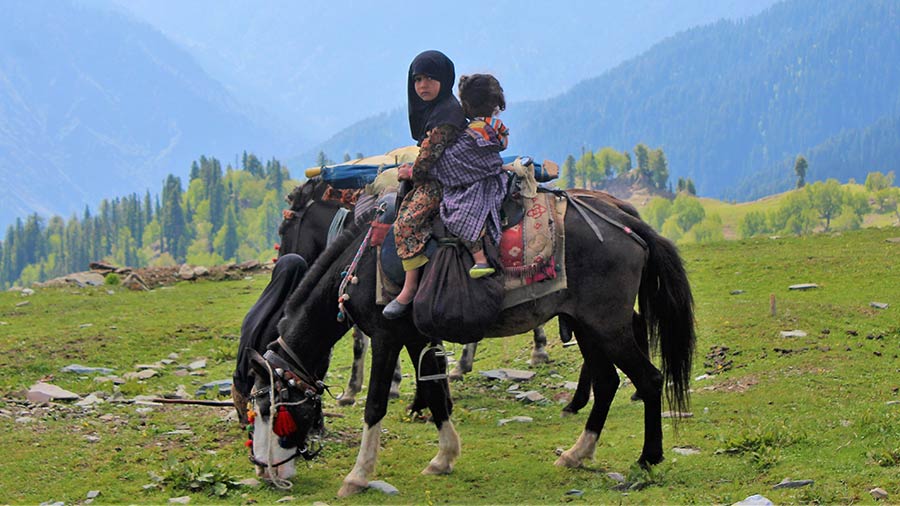
Nomad children on Razdan Pass
The group halted right next to where we stood, admiring the view of the overlapping green hills with the snow-capped Harmukh peak sparkling like a diamond on top. But it was time for us to leave. We still had some way to go. Besides, no one knew how many security checkpoints we were yet to cross.
We were on our way to Gurez, after all, an untouched valley in north Kashmir’s Bandipora district that had remained closed to outsiders until 2007 because of its proximity to the Line of Control (LoC). Over the years, the palaver of visiting Gurez (or Gurais) has been diluted to multiple identity checks and entries in Army, BSF and police logbooks, starting from the approach to the 11,672ft Razdan Pass.
The distance from Srinagar to Dawar, the main town in Gurez, is about 137km. But it can take six to seven hours by car, thanks to the checks. We had set off at 6.30am keeping that in mind, but my gender had helped us get a quick pass at the first checkpoint!
As our driver Tanveer and I had walked up the chilly and misty forested path, a jawan had come running, “Madam, you don’t have to stand in the queue. Leave your papers with the driver and go back to the car.” And within minutes, we had been on our way again.
Tokens to paradise
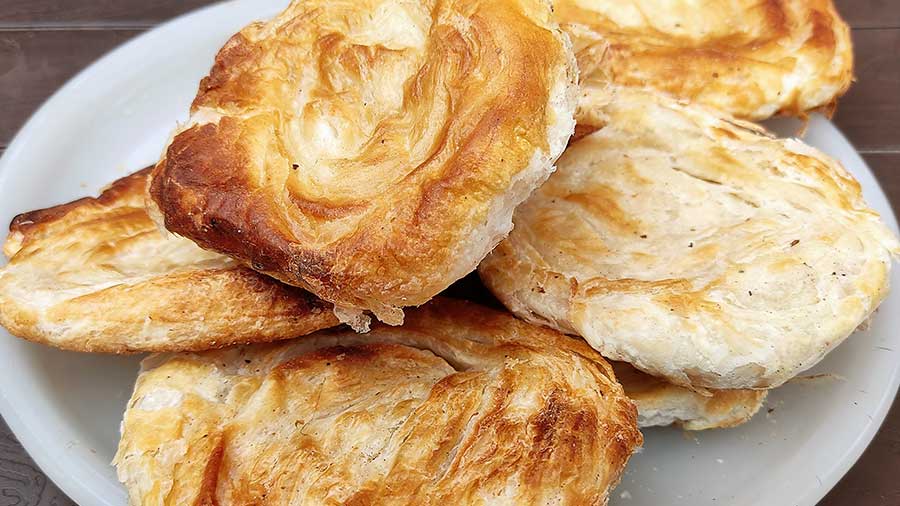
Bakarkhanis we had for breakfast after crossing Razdan Pass
Shortly after crossing the pass, we stopped for a breakfast of bakarkhanis (a type of flatbread) and Kashmiri noon chai (salt tea) at a roadside eatery. We ate in the open, surrounded by men, mostly local tourists out to spend the weekend in Gurez. There was a separate enclosure for the womenfolk. But the men spoke to my two female friends and me casually; no one told us to go to the “women’s space”.
The landscape had changed dramatically from the forested approach to Razdan Pass. Verdant hills draped in rows of deodar appeared against the blue sky, the hillside often dotted with the white foxtail lily or the purple Himalayan thyme.
We faced the second and bigger round of identity checks at the entry point to Gurez, a combined one by the Army and police. We had been handed a token — merely a chit torn out of a notebook — at the previous checkpoint. We got two this time. They had to be stored and shown on the way back.
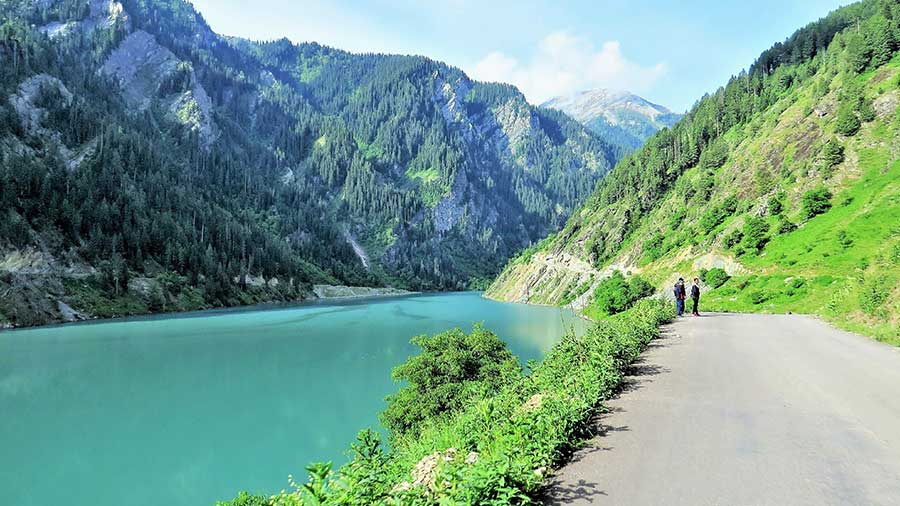
The dammed Kishanganga at Kazalwan
Within minutes of resuming our journey, we met the Kishanganga — the river that feeds the vales of north Kashmir — in Kazalwan. The dammed river, which runs parallel to the LoC and is called the Neelum across the border, has acquired a brilliant aquamarine hue here. And within 10 minutes, we were in Dawar, conspicuous by the pyramidal Habba Khatun peak, named after the 16th-century Kashmiri poetess-queen.
After entering our details for the final time that day, we crossed a bridge on the Kishanganga to enter the town.
Never far from an adda
Since 2019, tourist accommodations have mushroomed all over Dawar. So, it wasn’t difficult to find rooms despite the weekend crowd. After a late lunch of gushtabas (meatballs in a yoghurt gravy) and lamb kebabs, we went out for a walk. Our aimless stroll took us to the nearby Markoot village.
The first tea invitation came from the elderly owner of a construction goods shop at the mouth of the village. The second one came within minutes, when my friend stopped to photograph a family sitting on their porch. This is something I have seen only in Kashmir. People never think twice before inviting strangers in for tea!
Another striking feature is their laidback lives. Bands of men or women (rarely together) lazing on stairs, on top of a culvert or on the roadside are common sights. They never fail to remind me of the ‘Bangali adda’. And that is also how we found the bunch of girls who enthusiastically offered to show us the chashma (spring) that supplies water to the village.
They were all in hijab but not cagey. The oldest, Rubina, studied till Class XII before domestic duties forced her to drop out. The rest — Zainab, Tabassum, Iram, Iqra, Alia and Samreena — were in classes VII or VIII at the local school. As they led us through fields, across a stream, and up a hill, Rubina offered a glimpse into their lives.
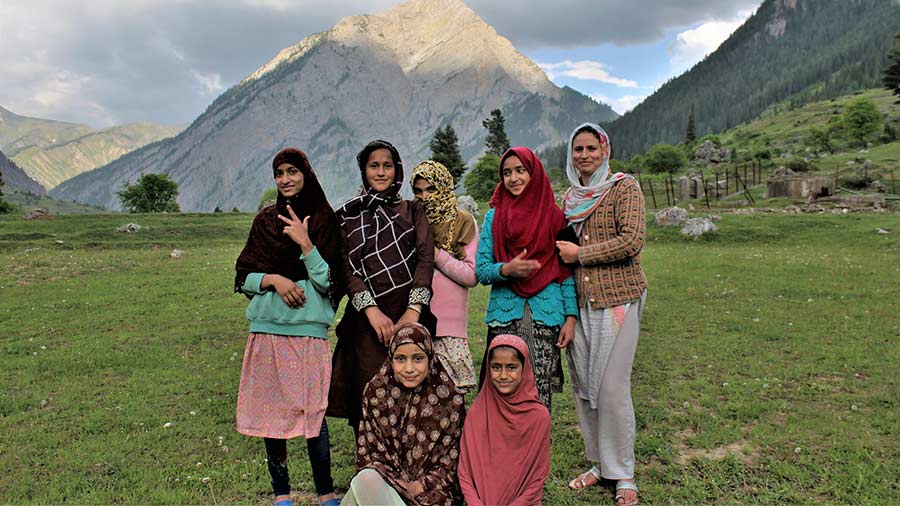
Rubina (extreme right) and the girls pose for a picture against the backdrop of Habba Khatun peak
They live in Gurez for six months a year, growing rajma, peas, wheat and potatoes, before leaving for Bandipora town during the harsh winters, when the entire valley gets severed from the rest of the world. One of her brothers is in the army, while two others manage the family-owned shop in Bandipora. We later met her family over a lavish tea, with Rubina placing bowl after bowl of cookies and namkeens on the mat before us.
To the last village… or not?
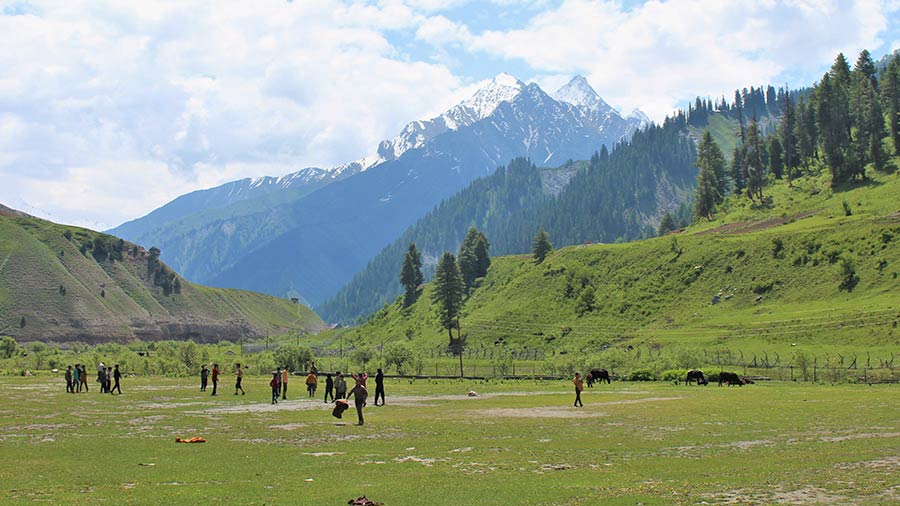
Kids play football at Hussaingam
Rubina and the rest of the people in this part of Kashmir are Dards, who speak Shina. They share their ethnicity with a section of people in Gilgit-Baltistan across the LoC and Dras in Ladakh, separated by inhospitable terrain from the valley of Tulail to the east of Gurez. The last village in the Tulail valley on the border with Ladakh is Chakwali, for which we set out the next morning.
We carried packed lunches because there would be no eateries on the way. The road ran parallel to the Kishanganga, which snaked its way through the fecund valley, skirting grassy hills and nourishing the fields of the adjoining little villages. Alongside ran the barbed-wire fence, never letting us forget our sensitive location, even though everyone I spoke to said Gurez was “very safe”.
Facing a disappointment
After a couple of entries on the way, we reached Tulail police station, from where we collected the permit to visit Chakwali. We were stopped again 19km later, at Hussaingam, this time by the Indian Army. We found out then that despite the police permit, the ultimate authority to allow someone to Chakwali rests with the Army.
One of the two men at the post went to get us tea while the other spoke to the commanding officer at Chakwali. After a brief conversation, he said, a trifle apologetically, that we had not been allowed to visit Chakwali because of “road repairs”. We could go up to Angaikot, 13km before the last point. We later learnt that all tourists during that time had faced the same disappointment.
We set off after depositing our original identity cards at Hussaingam. There was yet another check 4km ahead, at Baruab, where the road forked into two, one path vanishing around the hills towards Chakwali and the other leading to Angaikot.
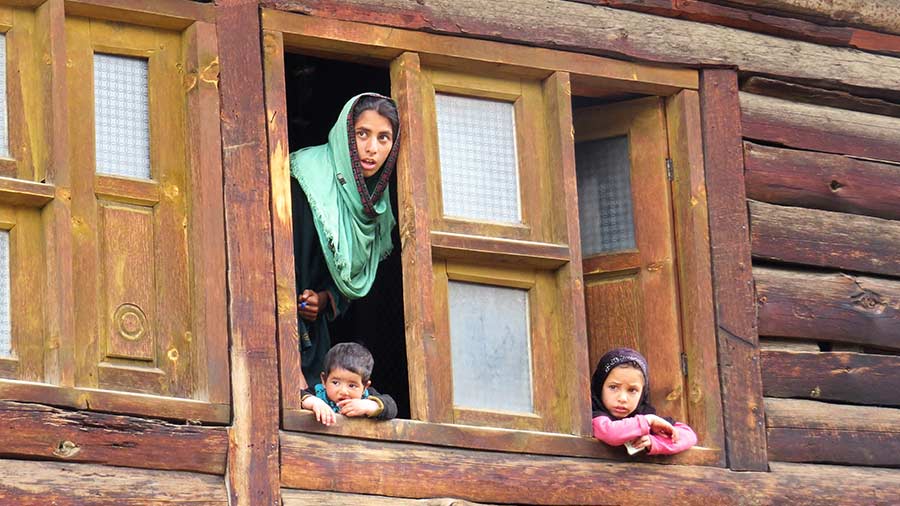
Curious villagers in Angaikot
Angaikot turned out to be a beautiful village nestled among lush hills, with the Kishanganga flowing right past. We spent some time admiring the village and its traditional log houses before starting the 45km journey back to Dawar.
“Aap mehmaan hai…”
Despite the long day, we went for a walk to Dawar market that afternoon. The modest Iqram Bakery drew our attention. We bought a box of cookies and decided to pick up some fresh bakarkhanis the next morning for our onward journey to Kupwara. Not only did the owner give us some of his biscuits as a gift, but he also refused to accept money for the bakarkhanis the next morning.
My protestations were met with a simple smile: “Aap mehmaan hai. Tohfa samajh ke rakh lijiye. (You are guests. Think of these as a gift.)”
The loaves were still warm to the touch. Or, was it the warmth of a stranger’s benevolence? I cradled the precious package as I got back into the car and we hit the road again, eager to know Kupwara next.
